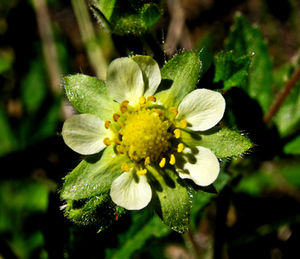Drymocallis glandulosa
- Scientific Name: Drymocallis glandulosa subsp. glandulosa
- Family: Rosaceae
- Common Names: sticky cinquefoil, Douglas's cinquefoil
- Synonyms/Misapplications: Potentilla glandulosa, D. glandulosa vars. reflexa, wrangelliana.
- Codon: DRYGLA
Contents
Taxonomy
| Scientific classification | |
|---|---|
| Kingdom: | Plantae |
| Subkingdom: | Viridiplantae |
| Phylum: | Tracheophyta |
| Subphylum: | Spermatophytina |
| Class: | Magnoliopsida |
| Subclass: | Rosanae |
| Order: | Rosales |
| Family: | Rosaceae |
| Genus: | Drymocallis Fourr. ex Rydb. |
| Species: | Drymocallis glandulosa (Lindl.) Ryb |
| Subspecies: | Drymocallis glandulosa var. glandulosa (Lindl. Ryb) |
| Synonyms | |
| |
Description
Tufted glandular perennial herb with reddish stems.[2]
Inflorescence a few-flowered cyme, rotate flowers 5-petalled, corolla and calyx spreading to reflexed, in this subspecies, white or yellow petals slightly shorter than sepals.[3]
Leaves are alternate, stipulate, odd-pinnate compound.[3]
Fruit is a glabrous achene.[3]
Bloom Period
June - August[2]
Distribution
BC and south to California, on both sides of the Cascades, and east to Montana.[3]
Habitat
Open areas from lowland meadows to forest openings.[2]
Early-seral, disturbance adapted, shade-intolerant, requiring well-drained soil.[4]
Uses
Nlaka'pamux use of decoction as a general tonic, and a stimulant tonic. [5]
Propagation
Cold stratification not required. Sticky cinquefoil seeds are stimulated to germinate by warm temperatures, and germination may be enhanced by a stratification period. Sticky cinquefoil germinates on bare soil in full sun and often germinates profusely following scarification resulting from either mechanical treatments or heavy livestock use. In a greenhouse, fresh, untreated sticky cinquefoil seeds germinated 9 days after being sown.[4]
Photo Gallery
References
- ↑ Integrated Taxonomic Information System. Retrieved from https://www.itis.gov/servlet/SingleRpt/SingleRpt?search_topic=TSN&search_value=512539
- ↑ 2.0 2.1 2.2 WTU Herbarium, Burke Museum, & University of Washington. Retrieved from https://biology.burke.washington.edu/herbarium/imagecollection/taxon.php?Taxon=Drymocallis%20glandulosa
- ↑ 3.0 3.1 3.2 3.3 Hitchcock, C. L., Cronquist, A., Giblin, D., & Legler, B. et al. (2018). Flora of the Pacific Northwest: an illustrated manual. Seattle: University of Washington Press.
- ↑ 4.0 4.1 Reeves, Sonja L. 2008. Potentilla glandulosa. In: Fire Effects Information System, [Online]. U.S. Department of Agriculture, Forest Service, Rocky Mountain Research Station, Fire Sciences Laboratory (Producer). Available: https://www.fs.fed.us/database/feis/plants/forb/potgla/all.html [2020, June 2].
- ↑ Native American Ethnobotany Database. Retrieved from http://naeb.brit.org/uses/search/?string=potentilla+glandulosa




